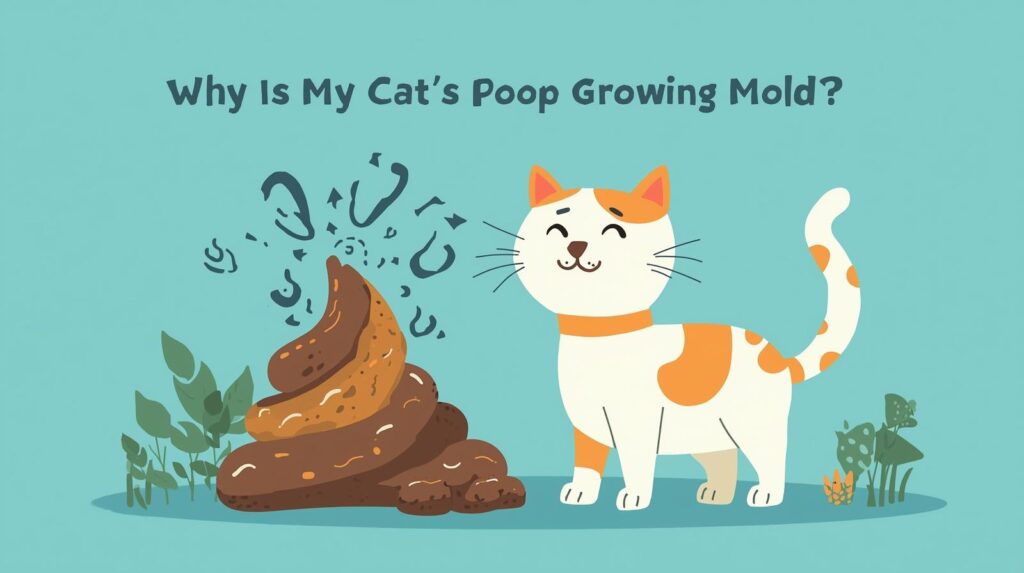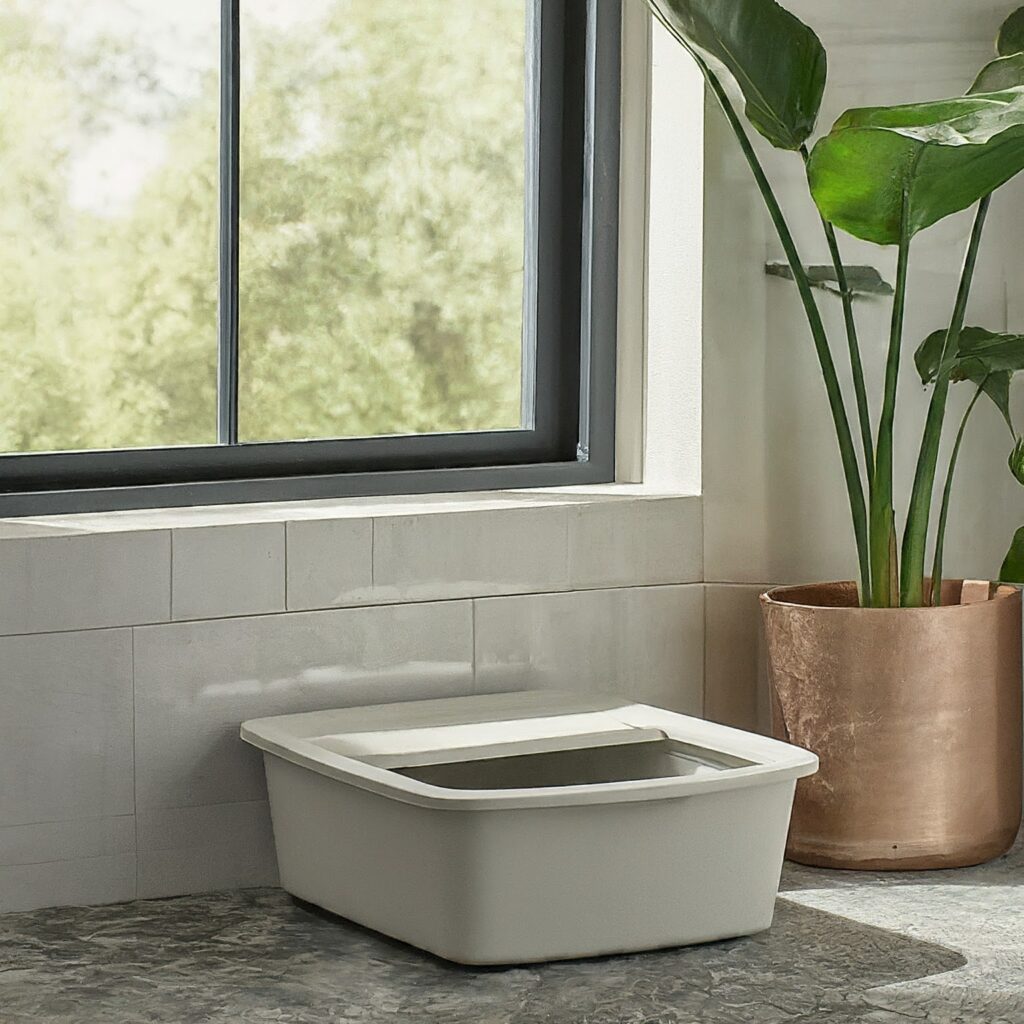
Have you ever scooped your cat’s litter box and noticed moldy white fuzz or green spots? That’s not normal. Moldy cat poop is more than just gross – it can be dangerous for your cat and even your family. Mold grows when poop sits too long in warm, moist conditions, releasing spores that carry toxins. If left untreated, this can lead to infections, breathing problems, or even serious illness.
In this blog, we’ll explore why moldy waste appears, how it harms cats and humans, and the best prevention steps. Let’s dive into what every cat parent should know.
Table of Contents
Why is My Cat’s Poop Growing Moldy?
The main reason poop becomes moldy is moisture. A litter box in a damp room, poor ventilation, or leaving waste unscooped for too long make the perfect environment for fungus. Unlike normal drying, moldy poop shows visible fuzz, discoloration, and sometimes smells sour.
Some molds, like Aspergillus, grow fast in these conditions. According to Invasive mould infections of the naso-orbital region of cats: a case involving Aspergillus fumigatus and an aetiological review, spores can cause severe infections if inhaled. That’s why spotting moldy cat poop early is critical.

What Does Unhealthy Cat Poop Look Like?
When you scoop the litter box, your cat’s poop can actually tell you a lot about their health. Healthy cat poop should be brown, firm but not too hard, and shaped like a small log. Anything that looks different may point to a problem. Here’s what to watch for:
1. Color Changes
- Black poop – may signal internal bleeding in the stomach or intestines.
- Green or yellow poop – could mean infection, liver problems, or dietary issues.
- White or gray poop – sometimes linked with bile duct or pancreas problems.
- Moldy cat poop – if you see white fuzz, blue spots, or unusual coating, it means fungus or bacteria are growing.
2. Texture & Shape
- Too watery/diarrhea – dehydration, parasites, or food intolerance.
- Too hard or dry – constipation, dehydration, or poor diet.
- Mucus coating – inflammation of the intestines.
- Poop covered in mold – happens if it sits in the litter box too long or if the home is damp.
3. Smell
- Normal poop smells bad but not unbearable.
- Extremely foul or sour smell can mean parasites, infection, or digestive issues.
- Moldy smell or sharp ammonia-like odor might point to dirty litter or fungal growth.
4. Other Warning Signs
- Blood in poop (red streaks or clots).
- Worms or white rice-like pieces inside the stool.
- Frequent accidents outside the litter box (the cat trying to avoid it).
What Readers Search For in This Section
Based on common searches, cat parents want:
- Pictures of unhealthy poop vs healthy poop
- Differences between diarrhea, constipation, and moldy cat poop
- If cat poop fungus is harmful to humans
- How long before mold grows on cat poop
- When to call a vet immediately
Key Tip for Readers: If you ever notice moldy cat poop, blood, worms, or strange colors, take a picture and contact your vet. These are not just litter box problems — they can be early signs of illness.
Is Cat Fungus Harmful to Humans?

Yes — certain types of cat fungus can be harmful to humans, especially if the spores spread through dirty litter, moldy cat poop, or contaminated surfaces. While not every fungus is dangerous, some can cause skin, respiratory, or even internal infections in humans. This is more likely in:
- People with weakened immune systems
- Children and elderly
- Pregnant women (due to risk of toxoplasmosis)
1. Types of Cat Fungus That Affect Humans
- Ringworm (Dermatophytosis) – spreads through cat fur, poop, or litter; causes itchy, red skin patches.
- Aspergillus fumigatus – can grow in moldy litter or poop; may cause respiratory problems.
- Candida & yeast – sometimes linked to dirty litter boxes.
- Toxoplasma gondii – a parasite in cat poop that can cause toxoplasmosis, which is dangerous for pregnant women.
2. How Humans Get Infected
- Scooping or cleaning moldy cat poop without gloves
- Breathing cat litter dust contaminated with fungus
- Touching infected cats and not washing hands
- Exposure to dirty cat litter boxes left uncleaned
3. Symptoms in Humans
- Skin rashes, itching, or ring-shaped spots
- Coughing, sneezing, or breathing problems (respiratory infections)
- Eye irritation or redness
- Flu-like signs in toxoplasmosis (fever, muscle pain, swollen glands)
The more you can understand: Prevalence of Microsporum canis from Pet Cats in Small Animal Hospitals, Chiang Mai, Thailand
4. Who Is Most at Risk?
- Immunocompromised individuals (HIV, cancer, organ transplant patients)
- Pregnant women – high risk of birth defects from toxoplasmosis
- Children & elderly – weaker immune defences
What Readers Actually Search For in This Section
Based on real search intent, cat owners usually want to know:
- Can humans catch fungus from cats?
- Is moldy cat poop dangerous to touch?
- Can cat litter fungus cause breathing issues?
- Is cat litter dust harmful to humans?
- How to clean fungus safely from a litter box?
- How to protect babies and pregnant women from cat fungus?
Key Tip for Readers: Always wear gloves and a mask when cleaning litter, scoop poop daily before it turns moldy, and wash your hands afterwards. A simple hygiene routine can prevent most infections.
Is Cat Litter Dust Harmful to Humans?
Yes, especially if combined with moldy conditions. Dusty clay litter holds moisture, creating clumps that trap spores. Breathing in litter dust with airborne fungal spores can damage lungs over time.
This is even more dangerous for kids, elderly family members, or people with asthma. Switching to low-dust litters like silica crystals or recycled paper can reduce risk and keep moldy growth away.
Is Dirty Cat Litter Toxic?
Yes — dirty cat litter can be toxic for both cats and humans if it’s not cleaned regularly. A litter box that isn’t scooped daily can turn into a breeding ground for bacteria, parasites, and mold. Over time, this waste releases ammonia fumes and can lead to serious health risks.
1. Toxic Risks for Cats
- Ammonia buildup → Dirty litter releases strong ammonia gas that can irritate your cat’s lungs, eyes, and throat.
- Urinary tract infections (UTIs) → Cats may avoid the litter box, hold pee too long, and develop painful UTIs.
- Paw contamination → Cats walk on dirty litter and then groom themselves, spreading harmful bacteria or fungus.
- Mold exposure → If poop turns into moldy cat poop, fungal spores can irritate your cat’s skin or cause digestive upset.
2. Toxic Risks for Humans
- Ammonia inhalation – Breathing ammonia from dirty litter can cause headaches, coughing, and breathing issues.
- Toxoplasmosis risk – Cat poop left too long can spread Toxoplasma gondii, especially dangerous for pregnant women.
- Fungal infections – Mold in old litter can release spores that trigger allergies or respiratory illness.
- Bacterial exposure – Dirty litter can carry E. coli, Salmonella, and parasites, putting your family at risk.
You can also check: Invasive fungal infections and oomycoses in cats: 1. Diagnostic approach
3. Signs That Dirty Cat Litter Is Becoming Toxic
- Strong ammonia smell even when you walk into the room
- Poop looks moldy, white, or fuzzy
- Cats refusing to use the litter box
- Family members coughing, sneezing, or getting frequent headaches
4. How Often Should You Clean It?
- Scoop daily – prevents mold and ammonia buildup
- Deep clean weekly – wash box with mild soap & hot water
- Replace litter fully every 1–2 weeks depending on usage
- Use clumping or low-dust litter to reduce fungal growth
Key Tip for Readers: Think of the litter box as your cat’s bathroom. If you wouldn’t use a dirty bathroom, neither will your cat — and the longer waste stays, the more toxic and moldy it becomes.
What Are the Signs of Toxoplasmosis in Humans?
Toxoplasmosis is an infection caused by the parasite Toxoplasma gondii, often found in dirty or moldy cat poop. While many healthy people may not show symptoms, the infection can be serious for pregnant women, newborns, and people with weak immune systems.
1. Common Symptoms in Healthy Adults
Most people may feel like they have a mild flu. Watch for:
- Fever and chills
- Headaches
- Muscle aches or body pain
- Fatigue and weakness
- Swollen lymph nodes (neck, underarms, groin)
These signs usually appear 5–20 days after exposure.
2. Severe Symptoms (High-Risk Groups)
In people with weak immune systems (HIV, cancer, organ transplant patients), toxoplasmosis can spread to the brain, eyes, or lungs. Symptoms may include:
- Confusion or trouble focusing
- Seizures
- Blurry vision or eye pain
- Difficulty breathing
- Severe headaches
3. Toxoplasmosis in Pregnant Women
If a woman becomes infected during pregnancy, the parasite can pass to the baby. Possible risks include:
- Miscarriage
- Stillbirth
- Premature birth
- Birth defects (vision problems, hearing loss, brain damage)
This is why doctors strongly recommend that pregnant women avoid cleaning litter boxes or use gloves and masks.
4. How People Get Toxoplasmosis
- Touching or inhaling moldy cat poop in dirty litter
- Eating undercooked meat (another source of the parasite)
- Drinking contaminated water
- Handling soil with cat feces without gloves
Key Tip for Readers: Healthy people often fight off toxoplasmosis naturally, but in high-risk groups, it can be life-threatening. If in doubt, ask your doctor for a blood test to check for infection.
Top 5 Dangers of Moldy Cat Poop for Cats & Humans
- Respiratory infections – caused by inhaling spores.
- Allergic reactions – sneezing, watery eyes, skin rashes.
- Skin problems – cats may get sores or dermatitis.
- Fungal spread – moldy spores cling to walls, carpets, and fabrics.
Toxoplasmosis risk – long-term exposure can cause chronic illness.
Real Case Studies – Cats & Owners Affected by Moldy Waste
On Moldy cat poop reddit, cat parents report seeing white fuzz covering poop after just two days in humid weather. One owner noticed their cat sneezing constantly after using a dirty box.
Another forum post, “Cat poop covered in white fuzz Reddit,” described how mold spread into the litter box corners, forcing them to replace the entire box. These real cases show that ignoring moldy waste is not just gross – it’s a health hazard.
Best Prevention Strategies Against Moldy Cat Poop
- Ventilation & humidity control: Keep boxes in dry, airy rooms.
- Litter choice: Silica gel and wood pellets resist moldy growth better than clay.
- Box placement: Avoid damp basements or bathrooms.
- Cleaning products: Use vinegar or enzyme-based cleaners (safe for cats).
- Cost & effort guide: Most prevention steps take just 10 minutes daily and less than $20 monthly.
Tip: Use two litter boxes per cat. This gives them options and prevents long storage of waste, reducing moldy buildup.
Warning Signs in Cats & Humans That Mold Has Spread
Cats:
- Sneezing and nasal discharge
- Lethargy or refusal to eat
- Avoiding litter box
- Diarrhea or vomiting
Humans:
- Asthma attacks
- Constant coughing
- Skin rashes
- Headaches after cleaning litter
If you notice these alongside moldy growth in the box, it’s time to act fast.
Vet-Recommended Products
- Pet-safe litter box disinfectant
Use cleaners that are non-toxic, fragrance-free (so cats don’t reject the box), kill fungus & bacteria.
2. Low-dust / mold-resistant cat litter
Silica, wood pellets, recycled paper — litters that don’t retain moisture or produce airborne dust that carries spores.
3. Automatic litter box with self-cleaning
Helps remove waste quickly so moldy cat poop sits less; less manual contact.
4. Litter box liners and mats
Helps reduce spillage and keeps area around litter box cleaner so less chance of mold spreading.
Further readings
Faqs-Moldy Cat Poop
Moldy cat poop pictures
Yes, photos help cat owners identify moldy growth. Compare normal vs fuzzy, discolored poop.
Moldy cat poop reddit
Many users share experiences of litter boxes turning moldy within 24–48 hours in humid climates.
Is moldy cat poop dangerous?
Yes. Spores release toxins that harm both cats and humans. Always scoop and clean daily.
How to treat moldy cat poop?
Dispose of affected litter, disinfect the box, and improve airflow. If symptoms persist, visit the vet.
White moldy cat poop?
Often caused by fungal colonization like Candida. Needs quick cleaning and vet check.
Mold on cat poop litter-Robot?
Automatic boxes may trap moisture, leading to moldy buildup if not cleaned often.
Wrapping up
Moldy cat poop is a warning sign that your litter care routine needs improvement. Ignoring moldy waste can expose your cat and family to fungal infections, allergies, and toxins.
The good news? With daily scooping, the right litter choice, better airflow, and regular cleaning, you can keep your cat’s box fresh and mold-free.
Take action today – because a clean litter box means a healthier cat, and a safer home.






